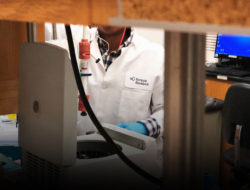3-D printers have been all the rage for the DIY obsessed. They can make raw plastic into anything—toys, coasters, lamps, you name it—and a restaurant in London even found a way to use one to create a nine-course meal. Scientists upped the ante and managed to 3-D print the nigh-unthinkable: living tissue and human organs.
The concept may sound like Frankenstein at first, but it could revolutionize organ donation and transplant surgery.
Say What?
Instead of plastics or metals, 3-D bioprinting uses different cell types as “ink” and places them in a specific pattern similar to naturally occurring tissues. Once in the proper pattern, the cells form connections to one another and begin to carry out the functions of that tissue.
Medical Marvels
Dr. Anthony Atala’s team at the Wake Forest Institute for Regenerative Medicine bioprinted jawbone fragments with microchannels to allow for nutrient diffusion and possible vasculature growth.
Dr. Stuart K. Williams at the University of Louisville’s Cardiovascular Innovation Institute set a goal to 3-D bioprint an entire human heart within the next ten years.
Techshot, an Indiana defense contractor, has a prototype of a 3-D bioprinter that can withstand space travel. They’ve already tested it on a zero-gravity flight.
Local Leader
In San Diego, Organovo is bioprinting tiny human liver and kidney tissues to help identify toxic drugs before they reach clinical trials. It’s also in preclinical studies with a “dollar bill sized” liver patch that could help extend the lives of patients on liver transplant lists.
L’Oréal has developed and patented its own 3-D bioprinted human skin, called Episkin, to help eliminate animal testing. They’ve partnered with Organovo to produce enough to sell to other cosmetics firms.
According to the FDA, liver and kidney toxicity are the most common reasons for a drug to be pulled from clinical trials—or from the market.
10 Years: Average time it takes for a new medicine to go from initial discovery to marketplace
$2.6 Billion: Average estimated cost to research and develop each successful drug
12 Percent: Percentage of drugs entering clinical trials that become an approved medicine (Source: Pharmaceutical and Research Manufacturers of America)
17K: Patients on the U.S. liver transplant waiting list
6K: Liver transplants performed each year in the U.S.
The Chen Laboratory at UC San Diego is developing a two-step bioprinting process that has the potential to create a vasculature network within bioprinted liver tissue. Tissue size is limited by how far oxygen and nutrients can diffuse, so a vascular network is needed to build larger tissues.
Tags: Innovation, Medicine, Next Big Thing, Tech






























